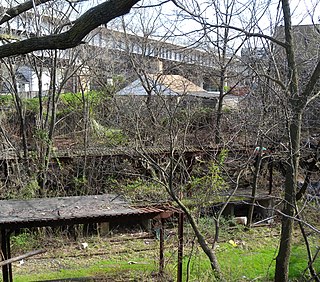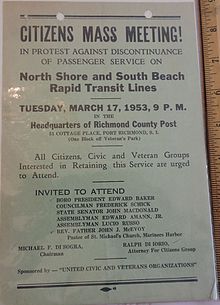
The Staten Island Railway (SIR) is a rapid transit line in the New York City borough of Staten Island. It is owned by the Staten Island Rapid Transit Operating Authority (SIRTOA), a subsidiary of the Metropolitan Transportation Authority, and operated by the New York City Transit Authority Department of Subways. SIR operates 24 hours a day, seven days a week, providing local service between St. George and Tottenville, along the east side of the island. There is currently only one line on the island, and there is no direct rail link between the SIR and the New York City Subway system, but SIR riders do receive a free transfer to New York City Transit bus and subway lines, and the line is included on official New York City Subway maps. Commuters on the railway typically use the Staten Island Ferry to reach Manhattan. The line is accessible from within the Ferry Terminal, and most of its trains are timed to connect with the ferry. In 2022, the system had a ridership of 3,757,700, or about 14,800 per weekday as of the first quarter of 2023.

Port Ivory is a coastal area in the northwestern corner of Staten Island, New York City, New York, United States. It is located on Newark Bay near the entrances the Kill van Kull in the east and Arthur Kill in the west. It is bordered by Arlington to the east, Old Place to the south, Newark Bay to the north, and the Arthur Kill to the west.
Staten Island light rail proposals refer to two projects in the New York City borough of Staten Island. These proposals are among the several light rail projects that have been floated in New York City in recent years. Neither proposal was funded in the Metropolitan Transportation Authority's 2015–2019 Capital Plan, but $4 million was allocated to a study for it.

The Richmond Valley station is a Staten Island Railway station in the neighborhood of Richmond Valley, Staten Island, New York. Located at Richmond Valley Road and Amboy Road on the main line, the station is a mixture of open cut at the north end and grade level at the south end.
Linden Yard is the name of two separate railroad freight yards in Linden, New Jersey, United States. One is owned by the Staten Island Railway (SIR) and the other is managed by Conrail Shared Assets Operations along the Northeast Corridor (NEC) right of way.
Arlington was a station on the abandoned North Shore Branch of the Staten Island Railway, in Staten Island, New York. Located in an open-cut 5.2 miles (8.4 km) from the St. George Terminal, it had two tracks and one island platform. For a few years before its closure in 1953, it was the western terminus of the North Shore Line; before then, the terminus was the Port Ivory station to the west, though most trains terminated at Arlington. It was located in the Arlington and Mariners Harbor sections of Staten Island, near the Arlington Yard, under the South Avenue overpass, between Arlington Place and Brabant Street.
New Brighton was a station on the abandoned North Shore Branch of the Staten Island Railway. It had two tracks and two side platforms. It was located in the New Brighton section of Staten Island, at the north end of Westervelt Avenue and Richmond Terrace. It was the closest original North Shore station to the Saint George Terminal, 0.7 miles (1.1 km) from the station.

Sailors' Snug Harbor is a former station on the abandoned North Shore Branch of the Staten Island Railway. It had two tracks and two side platforms. Located in the Livingston section of Staten Island north of Richmond Terrace, the station was approximately 1.2 miles (1.9 km) from Saint George Terminal. It is at the northernmost end of the Snug Harbor Cultural Center and Botanical Garden.

West New Brighton, also referred to as West Brighton, is a station on the abandoned North Shore Branch of the Staten Island Railway. It had two side platforms and two tracks. It was located at-grade in the West New Brighton section of Staten Island, north of Richmond Terrace between North Burgher Avenue and Broadway. The station site is 2.4 miles (3.9 km) from the Saint George terminus. No trace of the station exists today.

Port Richmond is a station on the abandoned North Shore Branch of the Staten Island Railway. Located in Port Richmond on a concrete trestle at Park Avenue and Church Street, it has two tracks and an island platform. The station is located approximately 3 miles (4.8 km) from Saint George Terminal.
Harbor Road was a station on the abandoned North Shore Branch of the Staten Island Railway in Mariners Harbor, Staten Island, New York. The station, located under the overpass at the highest point of Harbor Road, was built in an open-cut with two tracks and one island platform. It was located 4.9 miles (7.9 km) from the Saint George terminal. The station was opened during the SIRT grade crossing elimination project of 1935 – 1937. It closed on March 31, 1953, along with the South Beach Branch and the rest of the North Shore Branch. The station was demolished in 2004 during a reconstruction of the rail system for reactivated freight service by the nearby Howland Hook Marine Terminal.

Tower Hill is a station on the abandoned North Shore Branch of the Staten Island Railway, located in Tower Hill between the Port Richmond and Elm Park neighborhoods. The station lies between Treadwell and Sharpe Avenues about 3.4 miles (5.5 km) from the Saint George Terminal, with two tracks and an island platform. It is one of the three best-preserved stations on the line, the other two being Port Richmond and the line's western terminus at Arlington, in Mariners Harbor.

Elm Park is a station on the abandoned North Shore Branch of the Staten Island Railway (SIR). The station is located in an open cut under the Bayonne Bridge approach in Elm Park, Staten Island, at Morningstar Road between Innis Street and Newark Avenue. It has two tracks and two side platforms. The station is approximately 3.9 miles (6.3 km) from the Saint George terminal of the SIR.

Livingston is a former station on the abandoned North Shore Branch of the Staten Island Railway. Located north of Richmond Terrace at Bard Avenue in the Livingston section of Staten Island, it had two tracks and two side platforms. The site is 1.8 miles (2.9 km) from the Saint George terminal. Closed in 1953, the station was demolished, with few remnants of the site today.

The Staten Island Tunnel is an abandoned, incomplete railway/subway tunnel in New York City. It was intended to connect railways on Staten Island to the BMT Fourth Avenue Line of the New York City Subway, in Brooklyn, via a new crossing under the Narrows. Planned to extend 10,400 feet (3,200 m), the tunnel would have been among the world's longest at the time of its planning, in the late 19th and early 20th centuries.

The South Beach Branch, also called the East Shore Sub-Division, is an abandoned branch of the Staten Island Railway in New York City, which operated along Staten Island's East Shore from Clifton to Wentworth Avenue. This 4.1-mile (6.6 km) double-tracked branch left the Main Line at 40°37′08″N74°04′18″W, south of the Clifton station, and lay to the east of the Main Line.

The Travis Branch is a branch of the Staten Island Railway in New York City, that operates from Arlington Yard to Fresh Kills, which is used for freight transportation along the West Shore, Staten Island.

The Staten Island Railway (SIR) is the only rapid transit line in the New York City borough of Staten Island and is operated by the Staten Island Rapid Transit Operating Authority, a unit of the Metropolitan Transportation Authority. The railway was historically considered a standard railroad line, but today only the western portion of the North Shore Branch, which is disconnected from the rest of the SIR, is used by freight and is connected to the national railway system.
The Baltimore and New York Railway was a railroad line built by the Baltimore and Ohio Railroad (B&O) from Cranford, New Jersey, to the western side of the Arthur Kill Bridge in New Jersey, connecting with the North Shore Branch of Staten Island Rapid Transit. The line was built to provide the B&O access to a terminal in New York City, in Staten Island. Today, the line is used by CSX Transportation for freight trains.



















